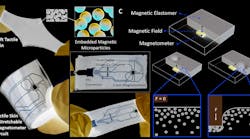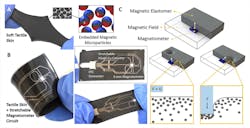Soft robots can safely be used to assist humans in moving items, treating patients, and gathering information. As interests in these robots keep growing, a team of scientists and engineers at Carnegie Mellon University are developing a way to give those robots the haptic or sensing capabilities found in natural soft tissue.
Most types of artificial skin that have a sense of touch require a wire for every single location on that skin where touch—including heat, cold, and pressure—can be detected. So, for large areas of skin, the wires may look like a bird’s nest, which complicates the electrical interface and makes it prone to defects and breakdowns.
“A lot of small wires might be fine inside hard cases such as smartphones and other devices, but if you’re talking about fabric, skin, or something else that’s soft and flexible, then suddenly all those wires become sources of failure,” says Carmel Majidi, an associate professor of mechanical engineering.
To avoid this hassle, Majidi and Tess Hellebrekers from his Soft Machines Lab have developed a soft magnetic skin with a single sensing element. This soft skin is composed of silicone rubber loaded with millions of microparticles. It is like a stretchy magnet that can be placed on robots, natural skin, or other surfaces to provide a sense of touch. Each particle has a north and south pole, together creating a magnetic field. When the material touches another object, the rubber detects the move and all the microparticles start moving around, thereby changing the magnetic field within the rubber.
A diagram shows the components of the soft magnetic skin.
These changes are detected by a magnetometer, an electronic chip embedded in the rubber skin. By measuring these changes, the magnetometer can infer the location and intensity of the contact, as well as estimate where the touch is and how hard it is pressing on the material’s surface.
“Force and contact are the two key factors for most skin sensing because it mimics our skin, which also relies on force and contact,” says Hellebrekers, a doctoral student in robotics.
What’s more, this skin doesn’t need to touch the material’s surface to sense contacts.
“The nice thing about magnets is that they cut through the air,” Majidi says. “You don’t have to have a physical connection to sense a magnetic field.”
Thanks to this attribute, the magnetic skin can be developed into a great tool for medicine. Biomedical engineers and doctors have become more interested in using soft robots in medicine, especially in gastrointestinal (GI) endoscopy. Although they have made great progress, it is still difficult to incorporate electronics and sensors because they tend to be bulky and rigid, which interferes with the endoscope’s mobility.
To further enhance the magnetic skin, Majidi’s team will try to detect force along cylindrical objects, which are similar to catheter endoscopes. They also aim to expand the sensing areas of the skin. Currently, the magnetic skin can localize contact over a continuous 1.5 cm² area. Researchers are looking at making the magnetic microparticles produce a larger magnetic field or placing the magnetometer in different locations.
Although their project is still in development, it opens a new door to soft robotics sensing.
“I really like this system because we can measure the magnetic field without any electrical interface,” Hellebrekers says. “That gives us a lot more freedom in designing the interface that is going to be easier to add into different devices.”


